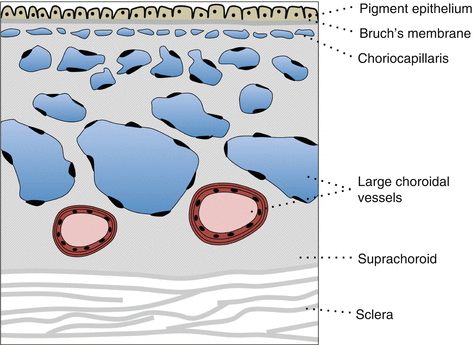(1)
University of Sydney, Sydney, Australia
Vascular Anatomy of the Eye (Fig. 11.1)
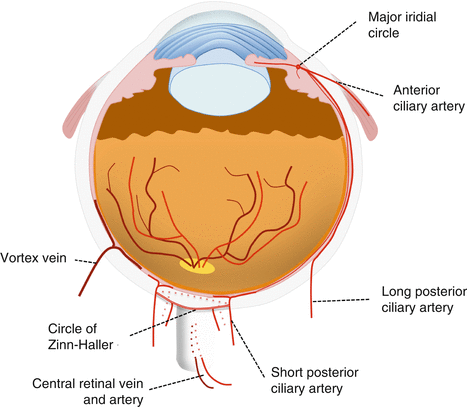
Fig. 11.1
Blood supply of the eye
Two separate vascular systems supply the eye:
(i)
The retinal vessels, including the central retinal artery (CRA), central retinal vein (CRV), and branches [1]
(ii)
The ciliary (uveal) vessels, including the short and long posterior and anterior ciliary arteries
Both systems arise from the ophthalmic artery, a branch of the internal carotid artery [2].
1.
Retinal vessels (Fig. 11.2)
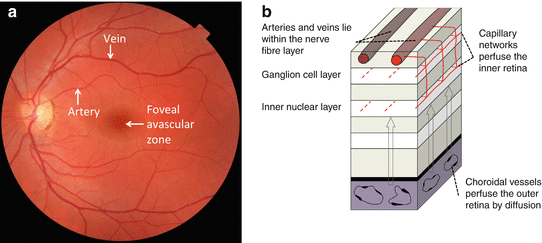

Fig. 11.2
Retinal vasculature; (a) fundal view; (b) retinal perfusion
(i)
Central retinal artery [3].
The CRA travels towards the eye within the optic nerve, entering the eye in the optic nerve head.
Retinal arteries have a well-developed smooth muscle layer and lack an internal elastic lamina [7].
The CRA supplies the inner retina; the outer retina is avascular, nourished from the choroid [8].
10–20 % of individuals have a cilioretinal artery, arising from the choroidal circulation; this typically enters the inner retina at the temporal optic disc margin and supplies some of the macula [9].
(ii)
Retinal capillaries and veins
Capillaries are arranged in lamellae within the inner retina (Table 11.1) [10, 11]:
Capillary layer
Location
Innermost
Peripapillary nerve fiber layer
Middle
Ganglion cell layer
Outer
Inner nuclear layer
Astrocytes surround retinal vessels and maintain their integrity [6].
Pericytes are contractile cells within capillary walls that regulate flow and endothelial functions.
The CRV exits the eye through the optic nerve and then drains into the cavernous sinus or superior ophthalmic vein.
2.
Ciliary vessels (Fig. 11.1)
The ciliary vessels include the vascular beds of the uveal tract.
(i)
The anterior ciliary vessels [14]
Seven anterior ciliary arteries provide the major blood supply to the anterior uvea.
Two travel with each rectus muscle (the lateral rectus has only one) and pierce the sclera anteriorly.
They anastomose with the long posterior ciliary arteries to form the major iridial circle [15].
This forms a ring around the iris peripheral margin supplying the iris and ciliary body.
(ii)
The posterior ciliary vessels [16]
10–20 short posterior ciliary arteries enter the sclera to form an anastomotic ring (circle of Zinn–Haller) around the optic nerve. This supplies the anterior optic nerve and posterior choroid.
Venous blood from the choroid and anterior uvea drains through four vortex veins.
3.
The choroid is a highly vascular uveal layer between the retina and sclera.
4.
The optic nerve head (see Fig. 12.6 in Chap. 12, The Optic Nerve) [20].
Most of the anterior optic nerve is supplied by the circle of Zinn-Haller and pial vessels [21, 22].
There is a small physiological break in the blood–neural barrier at the lateral optic nerve head, adjacent to the choroid (border tissue of Elschnig). Choroidal extravascular solutes may diffuse into the nerve tissue there [23].
Vascular Permeability (Fig. 11.4)
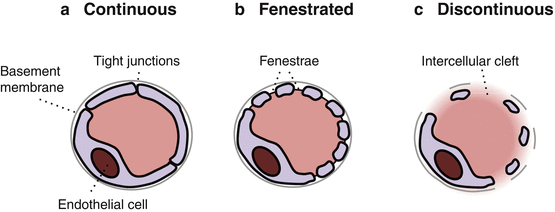
Fig. 11.4
Endothelial cell types
Vascular beds are highly permeable to lipid-soluble substances, CO2, O2, and probably water [25].
Permeability for water-soluble substances is determined by the fine structure of the endothelium [26].
In the ocular tissues, capillary endothelial structure can be either continuous or fenestrated [27]:
Blood-Ocular Barriers
The two main ocular barrier systems are the blood-aqueous barrier and the blood-retinal barrier [30].
1.
Function
The blood-ocular barriers are essential for controlling the microenvironment of ocular tissues.
They approximate the blood-brain barrier [31].
Like the brain, the eye requires strict control of extracellular solutes, hormones, and neurotransmitters to optimize cellular function and prevent toxicity [32, 33].
Blood-ocular barriers are impermeable to vital water-soluble molecules (e.g., glucose and amino acids); hence, energy–dependent carriers transport these molecules across the barriers [29].
2.
The blood-aqueous barrier (BAB) (Fig. 11.5a)
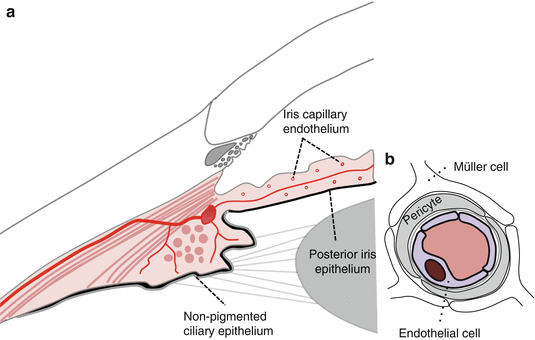

Fig. 11.5
Components of the (a) blood-aqueous barrier, (b) inner blood-retinal barrier
The BAB prevents aqueous mixing with serum, allowing fine control of aqueous composition [34].
(i)
Nonpigmented ciliary epithelium (NPCE)
(ii)
Iris capillary endothelium
The iris vessels have a continuous endothelium with low permeability [37].
The iris capillary endothelium preserves the BAB despite an absent anterior iris epithelium.
3.
The blood-retinal barrier (BRB) [38]
The BRB is formed by the continuous retinal capillaries and apical tight junctions of the retinal pigment epithelium (RPE) cells.
(i)
Retinal capillary structure (Fig. 11.5b)
The retinal capillaries are continuous with endothelial cells joined by non-leaky tight junctions.
Like the cerebral capillaries, these permit no permeability for ionic solutes [39].
Pericytes are contractile cells that form a discontinuous layer within the capillary wall [40].
Pericytes may regulate flow, capillary permeability, endothelial cell growth, and angiogenesis [7, 41, 42].
Glial cell (e.g., Müller cell) processes surround retinal capillaries and contribute to the BRB [38].
(ii)
Retinal pigment epithelium
The RPE cells have extensive apical tight junctions, forming the major barrier to substances from the choriocapillaris (see Figs. 9.1 and 9.4 in Chap. 9, The Retinal Pigment Epithelium) [43].
Bruch’s membrane has only minor barrier function; its overall negative charge restricts flow of negatively charged molecules [1, 44].
In addition the RPE actively pumps fluid from the subretinal space into the choriocapillaris [45].
The choriocapillaris has a fenestrated endothelium allowing extravasation of fluid, providing nutritional and metabolic support for the outer retina [46].
4.
Similarities of the blood-ocular barriers
Both separate a highly regulated extracellular compartment from a highly vascularized region: the aqueous humor from the ciliary stroma and the neural retina from the choriocapillaris [27].
They enable provision of essential nutrients (O2, glucose), removal of waste (CO2, lactic acid), and osmotic regulation of avascular intraocular structures (cornea, lens, vitreous, retina).
They selectively allow passage of substrates for local function (e.g., ascorbate for the lens; vitamin A for photoreceptor phototransduction) [1, 47].
They exclude large molecules that would interfere with local function (e.g., proteins that decrease aqueous clarity, neuropeptides that would impair retinal neural function) [30].
Retinal and Choroidal Circulation
The retinal circulation supplies the high nutritional demands of the retina without significantly impeding light transmission.
The choroid has a much higher blood flow than the retinal circulation. Its functions include heat dissipation from light focused on the retina and outer retinal nourishment [8].
The differences in these vascular beds are outlined below (Table 11.2):
Retinal circulation
Choroidal circulation
Tissue supplied
Inner retina
Outer retina
Blood flow
(% total ocular supply)
4 %
85 %
10× retinal flow (per unit mass)
Perfusion speed
Slow (3–5 s)
Fast (1 s before retinal perfusion)
O2 consumption
(% arteriovenous O2 gradient)
38 %
5 %
Retinal O2 supply (% total)
35 % of total retinal supply
65 % of total retinal supply
Capillary bed
Structure
Stratified capillary network
The choriocapillaris: a large endothelial-lined space interrupted by stromal pillars
luminal diameter
5 um
10–20 um
Passage of red blood cells
(7–8 um in diameter)
Deform under resistance
Move freely in sheet flow
Endothelial barrier
Continuous, forming blood-retinal barrier
Fenestrated allowing free flow of fluid and solutes into extravascular spacea
Intramural pericytes
Present
Absent
Large vessels
Anastamoses
End-on capillary supply with no physiological anastamoses
Blockages not bypassed
Lobular segmental supply of choriocapillaris with some arteriovenous anastamoses
Watershed areas between lobules exist
Change in vessel caliber
Progressive reduction from large arteries to capillaries
Abrupt change from short, wide arterioles to capillaries
Perfusion pressure
Moderate
High
Control of vascular tone
Autoregulation
Myogenic and metabolic mechanisms
Limited capacity for autoregulation in the subfoveal choroid, otherwise none
Neural vasomotor control
None
Sympathetic and parasympathetic innervation
Stay updated, free articles. Join our Telegram channel

Full access? Get Clinical Tree

 Get Clinical Tree app for offline access
Get Clinical Tree app for offline access

